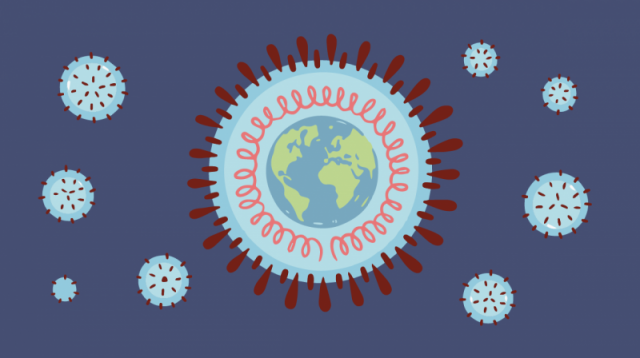Updates on research and information on COVID-19 and violence
Thu 03 Feb 2022
This article highlights some of the recent research and resources related to responding to and preventing violence in the COVID-19 pandemic.

Researchers and advocates have been exploring and documenting the impacts of the COVID-19 pandemic to victim/survivors, to staff and advocates, and to organisations working to address violence.
There is a growing amount of new research, guides and resources being published internationally. We regularly add these resources to our Library and they can be found by using our Quick Topic Search on COVID-19. Below we highlight findings and advice from some of this new research.
How violence has changed
Even before the pandemic, research had indicated that perpetrators' violence can change and become worse during emergencies like the COVID-19 pandemic. New research has begun to document ways in which perpetrators are using the pandemic and public health measures to further control, abuse and harm victims. For example see the following articles:
- Update: Locked out or let in? Learning from victim-survivors’ remote help-seeking experiences during COVID-19 (2023) explores victim | survivor experiences of accessing services, noting both increased challenges and in other cases, improved opportunities, to accessing services.
- Weaponizing COVID-19: how the pandemic influenced the behavior of those who use violence in domestic and family relationships (December 2021) explores how perpetrator's violence has changed
- Intimate partner violence during the COVID-19 pandemic: a survey of women in Australia (October 2021) reports findings from a survey of women in Australia about intimate partner violence and help seeking during the pandemic (also see the at a glance fact sheet)
- The Same Dynamics, Different Tactics: Domestic Violence During COVID-19 (August 2021) reflects on new tactics used by domestic violence perpetrators during the pandemic including insights from the US-based Battered Women's Justice Project
- ‘I Think it Just Made Everything Very Much More Intense’: A Qualitative Secondary Analysis Exploring The Role Of Friends and Family Providing Support to Survivors of Domestic Abuse During The COVID-19 Pandemic (June 2021) interviewed informal supporters of survivors about the changes they have observed
- Survivors’ Experiences of Intimate Partner Violence and Shelter Utilization During COVID-19 (June 2021) interviewed survivors engaged with services about their experiences
Reflecting on changes to services
Organisations and service providers have rapidly adapted and changed to continue services during the pandemic. For many agencies this has meant online and remote ways of working. It is important to review rapid changes made to services including changes that rely on technology. These changes may have created new ways of working, but they may also have introduced new barriers or risks to safety for victim/survivors.
The US-based National Network to End Domestic Violence encourages re-assessing these decisions to adopt new technology. They have created a Digital Services Toolkit which has a number of resources that can help.
The European Network for the Work with Perpetrators of Domestic Violence has developed a COVID-19 Revision of Practice Toolkit (2021) which invites providers to reflect on changes to their practice and consider positive and negative impacts, including how changes might affect risks.
Key questions to ask are whether the changes still fit and if the changes effectively address safety for victims. These articles from the Australia Institute for Families address Responding to the coronavirus pandemic: Documentation tips for monitoring and evaluation and Responding to the coronavirus pandemic: Assessing rapid service changes (June 2020).
For more information and Aotearoa New Zealand resources, see our section on Using technology safely to reduce face-to-face contact for Information for specialist family violence and sexual violence services.
Supporting organisations and staff
Many researchers have been documenting the impacts to organisations and staff who work to address violence. Advocates and staff have continued to experience increased personal, community and professional responsibilities and pressures from the impacts of the pandemic. We've previously highlighted The Best Practice Guidelines: Supporting the Wellbeing of Family Violence Workers During Times of Emergency and Crisis (2021) from Australian researchers. For more information see the news story below and our new resource page on Advocate and Worker Wellbeing (in the context of covid).
Data and statistics on violence
We've previously highlighted the many reasons it can be difficult to get accurate or meaningful statistics about gender-based violence during an emergency. In the article, The pitfalls of modelling the effects of COVID-19 on gender-based violence: lessons learnt and ways forward (2021), the authors identified five key critiques about using modelling to make projections about and measure gender-based violence. They conclude that "in uncertain and turbulent periods, local, context-specific GBV knowledge may make the most important contribution to rapid prevention and response efforts."
More information
We highlighted previous research in the first year of the covid pandemic in our FAQ Part 1: Understanding the impacts of COVID-19 and FAQ Part 2: Addressing the impacts of COVID-19.
More recently, we've updated key information across our webpages on Preventing and responding to family, whānau and sexual violence during COVID-19 which covers:
- Updates from government agencies (where to find key information related to responding and preventing violence)
- For family, whānau and sexual violence services
- For non-specialist services
- For people experiencing abuse
- For people using abuse
- For parents
- How to help
- Advocate and worker wellbeing.
We occasionally update these pages as new essential information is published. The information on our Te Whare Māori pages, compiled by Ngā Wai a te Tūī Māori and Indigenous Research Centre, is not being updated but remains an important resource. For up to date information about COVID-19 and support for Te Ao Māori, Te Puni Kōkiri's website provides a one-stop source of information.
Related news
As public health measures mean changing restrictions, such as self-isolation, it continues to be important that people know they can leave their home or bubble at any time if they are unsafe and that family violence and sexual violence services are always available. The official COVID19.govt.nz webpage lists helplines and where to go for help.
The Joint Venture Work Programme update for September 2021 included safety messages for wide distribution and identified five top line messages:
- Crisis services are open
- You can leave your bubble if you’re not safe
- Family violence and sexual violence support lines are open for people to call, email or text
- If someone is in danger call Police on 111
- When dialling 111 follow the operator’s instructions if you can’t speak.
Victim/survivors can also access the Shielded website for help. Remind victim/survivors to look for this icon ![]() at the bottom of websites. The icon opens the shielded.co.nz website. When you open the website by clicking on the icon, it won't appear in internet browser history. It has information on getting help.
at the bottom of websites. The icon opens the shielded.co.nz website. When you open the website by clicking on the icon, it won't appear in internet browser history. It has information on getting help.
Image: Philippa Steinberg for the Innovative Genomics Institute




